| 1 | Saw-toothed necked bronzeback |
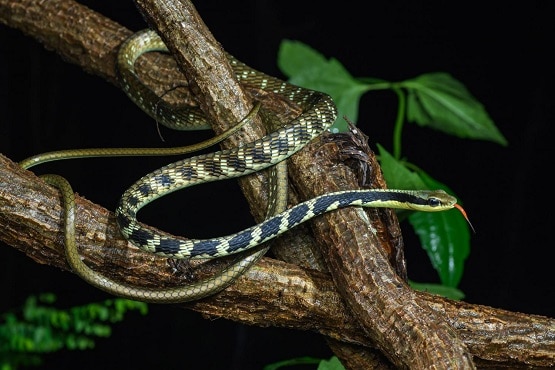
The bronzeback snake genus (Dendrelaphis) is huge, with 11 members living in Thailand alone, and over 40 existing worldwide. They share various characteristics such as a thin, whip-like body, spending most of their life in trees branches and possessing a mild, mostly harmless venom. One of the more recent additions was Dendrelaphis nigroserratus, the saw-tooth necked bronzeback, which was discovered only in 2012, amid a vast survey that saw 367 new species identified in Mekong.
This species lives in western and southwestern Thailand, on the Myanmar border. The saw-toothed necked bronzeback has been known about for over 100 years, but was originally declared as a subpopulation of the Wall’s bronzeback (a species with particularly huge eyes). Patterns revealed the difference, as this version had a unique black stripe travelling tailwards from each eye. At the neck, the colour becomes intermittently broken, and this creates the namesake sawtooth patterns, alternating repeatedly with yellow.
The sawtooth necked bronzeback is found in evergreen forests at around 800 metres in altitude, including in bamboo thickets, often on branches close to streams. Dendrelaphis nigroserratus moves by day, and has been observed eating frogs, like most bronzebacks.
This is also one of the largest of the bronzeback clan. 80-100cm is the norm, while one roadkill female measured 1.63 metres. No matter how long they are, they keep the usual thin, whiplike body.
| 2 | Hua Hin kukri snake |
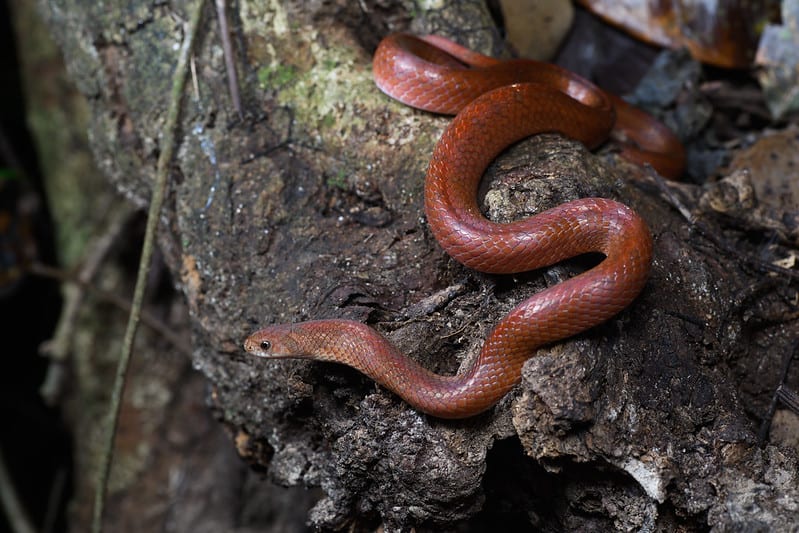
Only 7 living members of this species have ever been discovered. The Hua Hin kukri snake (Oligodon huahin) was discovered in 2016, somehow going unnoticed over thousands of years of human civilisation. The 7 living snakes were found in a 1000 square metre area of Thailand.
The Hua Hin kukri snake has an amber colour, but sometimes looks more like dried leaves, which is convenient given that it often lives in dried leaves. Hua Hin kukri snakes also live in bamboo forests, and coexist with several far more common species, such as monocled cobras and green catsnakes. The most common kukri snake in Thailand is the small-banded kukri snake (Oligodon fasciolatus), which inhabits virtually the whole country and is abundant in Bangkok itself. This is a sandy colour with noticeable brown bands, while the new species was significantly darker.
Although little about its lifestyle is known, all 7 Hua Hin kukri snakes were found crossing a road near bamboo stalks at 6:15-7:15pm, which hints that they’re most active at dusk. The location was approximately a 4 hour drive from Bangkok.
Later, the team found a dead Hua Hin kukri snake on a road 12km away. Clearly, its range wasn’t as narrow as first thought; the species was just an expert at flying under the radar for centuries. The largest Hua Hin kukri snake so far measures 55.4cm.
| 3 | Indochinese long-nosed whip snake |
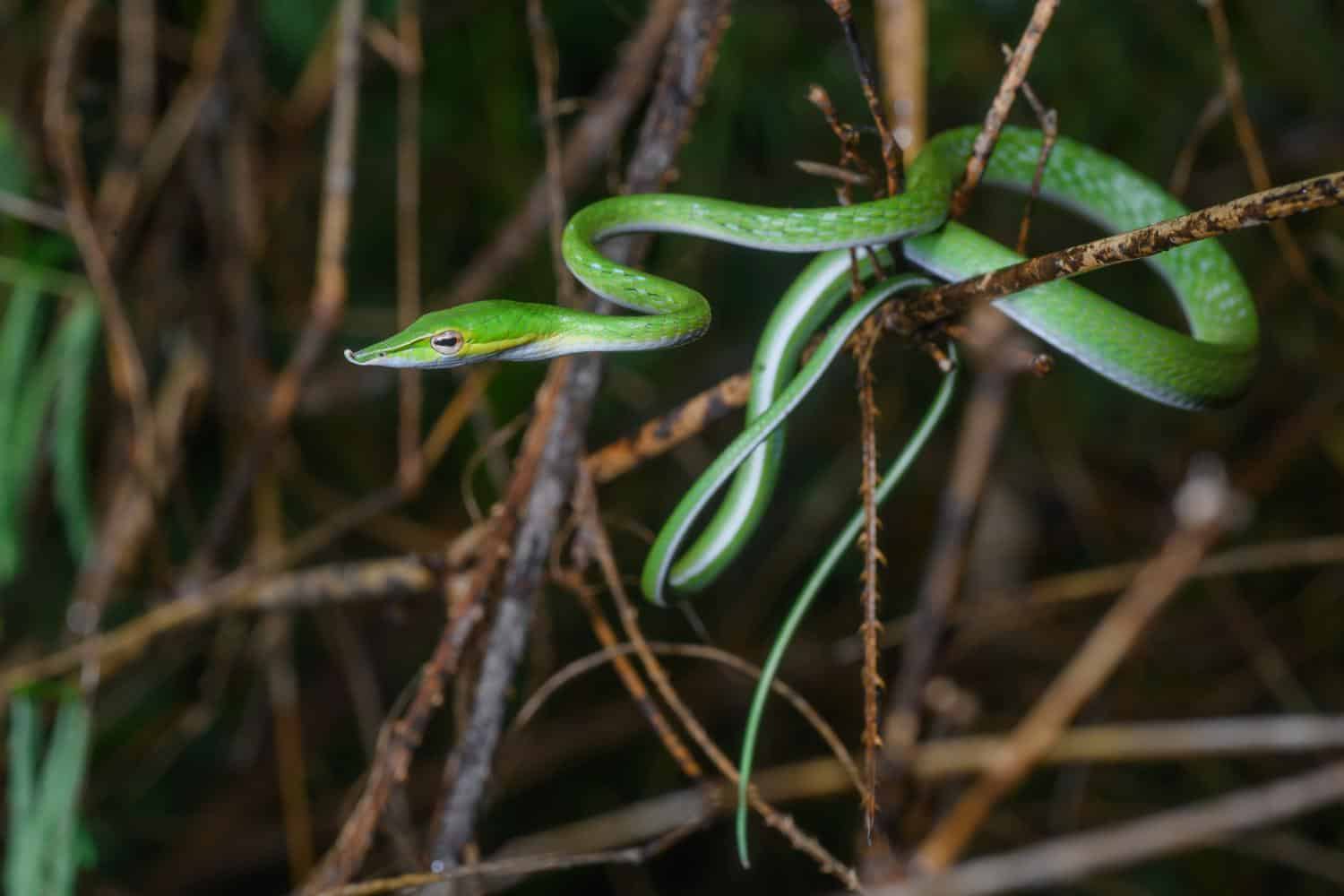
A relative of the bizarre Asian vine snake, with similarly bizarre attributes. There’s an ultra green body, which can easily be mistaken for a swinging vine, only for a set of serpent jaws to open from nowhere and swallow a lizard. There’s disturbingly shaped pupils, which in this case are horizontal. Finally, there’s an ultra-thin body, and a mostly tree-dwelling nature.
The Indochinese long-nosed whip snake (Ahaetulla fusca) is found all over Thailand except in the southern peninsula region, and is common around Bangkok. Originally, it belonged to the species Ahaetulla nasuta, also found in India and Sri Lanka, but this was split in two, with the eastern colonies becoming Ahaetulla fusca in 2022.
This species has a weak venom, which only passes the effect threshold if it chews repeatedly. Of all vine snakes in Thailand, Ahaetulla fusca is the longest, with a maximum of 200cm.
This snake coexists with Asian vine snakes (Ahaetulla prasina), but is genetically separated enough not to interbreed. The main difference is their extremely long nose, produced by a protruding scale. This is particularly noticeable head on. The Asian vine snake has a smooth face, while the long-nosed whipsnake looks crinkled, as though it should be wearing reading glasses. This nose even upturns at the end, to produce what looks like a scooping tool (a theory which may turn out to be true).
| 4 | White-bellied ratsnake |
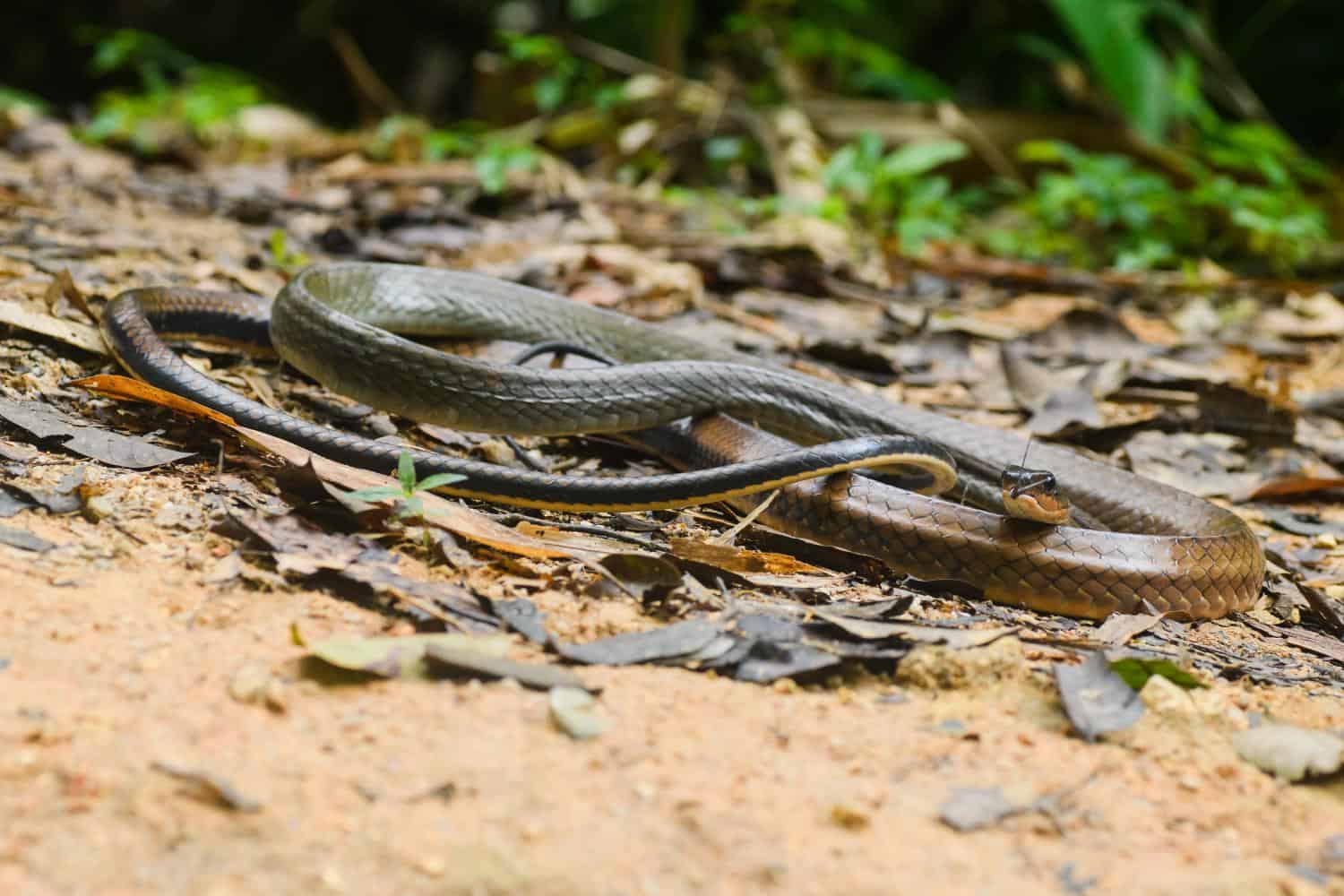
Named for its pristine white belly, which is a monolithic white and has no patterns. This is the less common relative of the ubiquitous oriental ratsnake, which strides aggressively around Thailand’s towns and cities. White-bellied ratsnakes (Ptyas fusca) are more common along forest streams well away from towns, but will also venture to hillsides and clearings within 50 metres of the forest edge.
White-bellied ratsnakes stick mainly to the southern peninsula regions of Thailand, and are also common in Singapore. At a record of 290cm, this is quietly one of Thailand’s longest snakes. Fortunately, they’re completely harmless, and have a classic tendency to freeze when confronted.
When Ptyas fusca detects a human, it usually stays motionless rather than fleeing, keeping its neck raised up. Eventually, it begins to move its neck from side to side, in a strange intimidation ritual. This species also has white eyes, which brightly reflect a camera’s flash.
Their colours looks generic at first glance, but they have a clear order. Ptyas fusca has a brown back, a clean white belly, and a black stripe on each flank separating the two. Their tongue is an oily blue colour, while their freezing tendencies mean that they’re very easy to photograph, as they commonly stay still for 1 minute.
| 5 | Hagen’s pit viper |
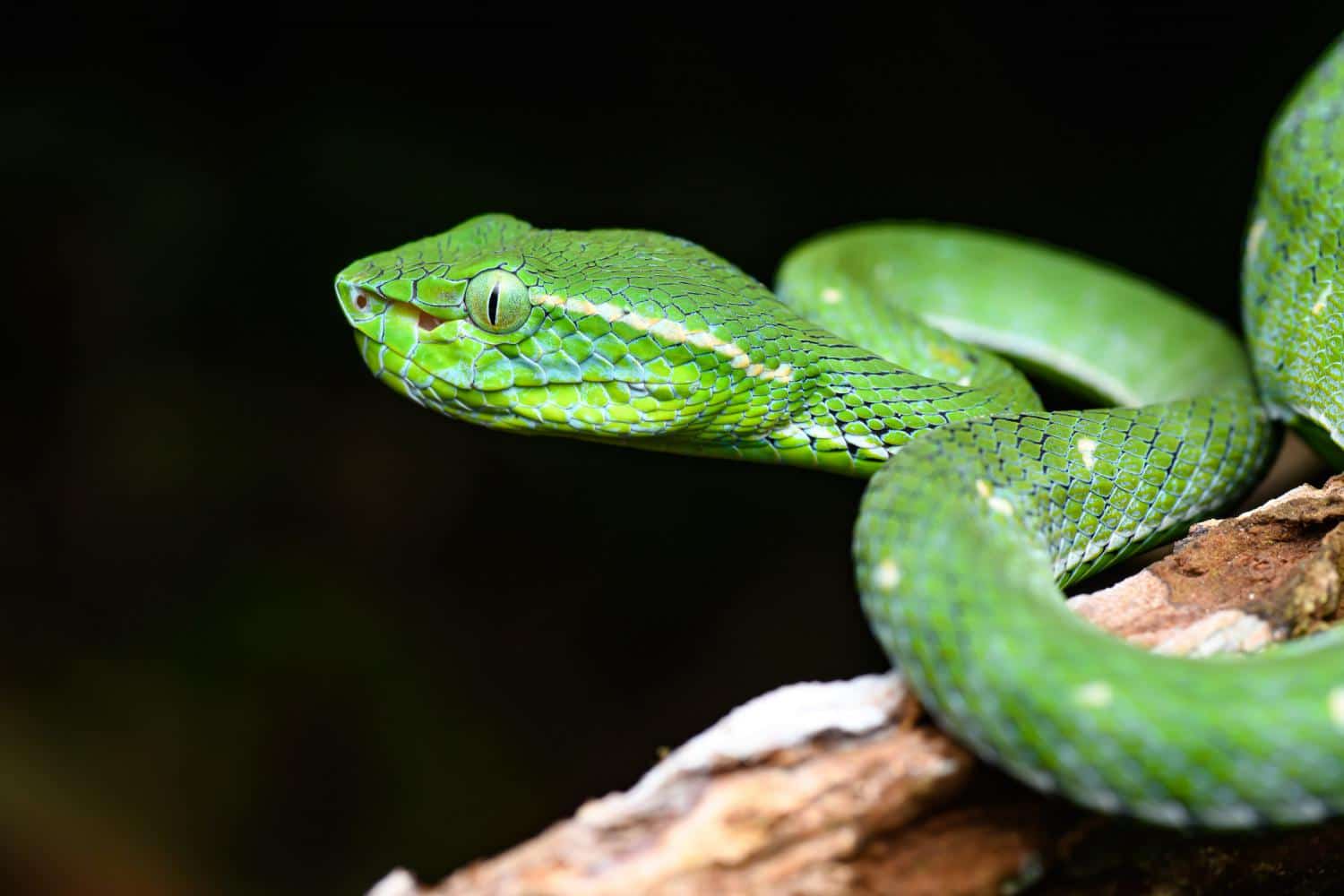
A savage, dangerous pitviper, which thankfully only exists in the far south of Thailand. Hagen’s pitvipers (Trimersurus hageni) also live in Sumatra and peninsular Malaysia, and closely resemble other Trimeresurus pitvipers at first glance. They have razor sharp vertical pupils, and are cloaked thoroughly in jungle green. They dwell mainly in forests, and are excellent tree climbers.
However, Trimersurus hageni has subtle yet clear differences to the most widespread member in Thailand, the white-lipped pitviper. Its eyes are green rather than yellow, continuing unbroken from its scales. It has a blue patch above its lips, and its head is particularly bulky. Hagen’s pitviper also has vivid black skin between each scale, looking like cracks in its armour. These black cracks also bleed into the signature white line on their flanks. They’re slightly longer too, at a record of 123.0cm.
The venom of Hagen’s pitviper contains 216 proteins, and is richest in metalloproteineases, which cleave through and disintegrate living cells. This species mainly eats mammals, and is rarely found above 600 metres in altitude. In 2022, they lost some territory, as three new Trimeresurus species were split off, replacing Hagen’s pitviper on Siberut Island, Nias Island and Simeulue Island. The Trimeresurus pitviper genus is gaining new members almost every year nowadays.
| 6 | Large-eyed bamboo snake |
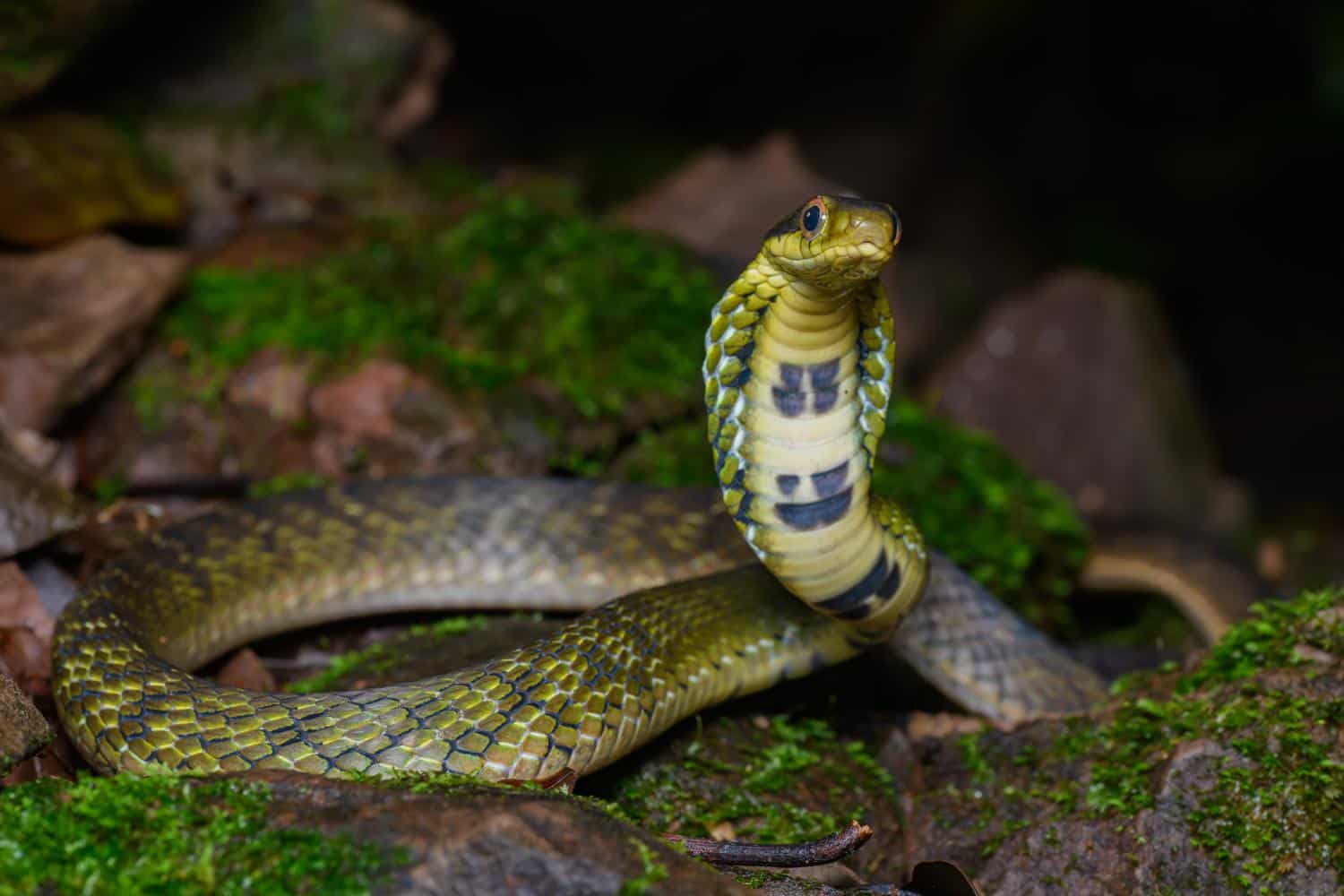
This weird snake looks like a cobra with at least one frog grandparent. It’s also called the Chinese false cobra, as imitating a cobra is one of its schemes to stay alive, complete with spreadable hood.
The large eyed bamboo snake (Pseudoxenodon macrops) measures up to 120cm, and also has a venom of its own, though the exact strength is a mystery. This snake lives in forests at moderate to high altitudes, and rarely appears below 1200 metres in Thailand. Their realm is primarily western and northern Thailand, meaning that you’ll never encounter this snake in the hustle and bustle of Bangkok, Phuket or Pattaya.
Large-eyed bamboo snakes will either flee or bite, if their cobra-mimicking schemes fail – they’re a hard snake to predict. They might even flip onto their back and play dead. Frogs are thought to be their favourite prey.
The Latin name of macrops references their large eyes. Some believe that the hood spread didn’t directly evolve to mimic cobras, but was advantageous independently, as it made them appear larger. However, they also have the signature black chest patches of a cobra, against a paler background, hinting that it really was mimicry.
| 7 | Indochinese ground snake |
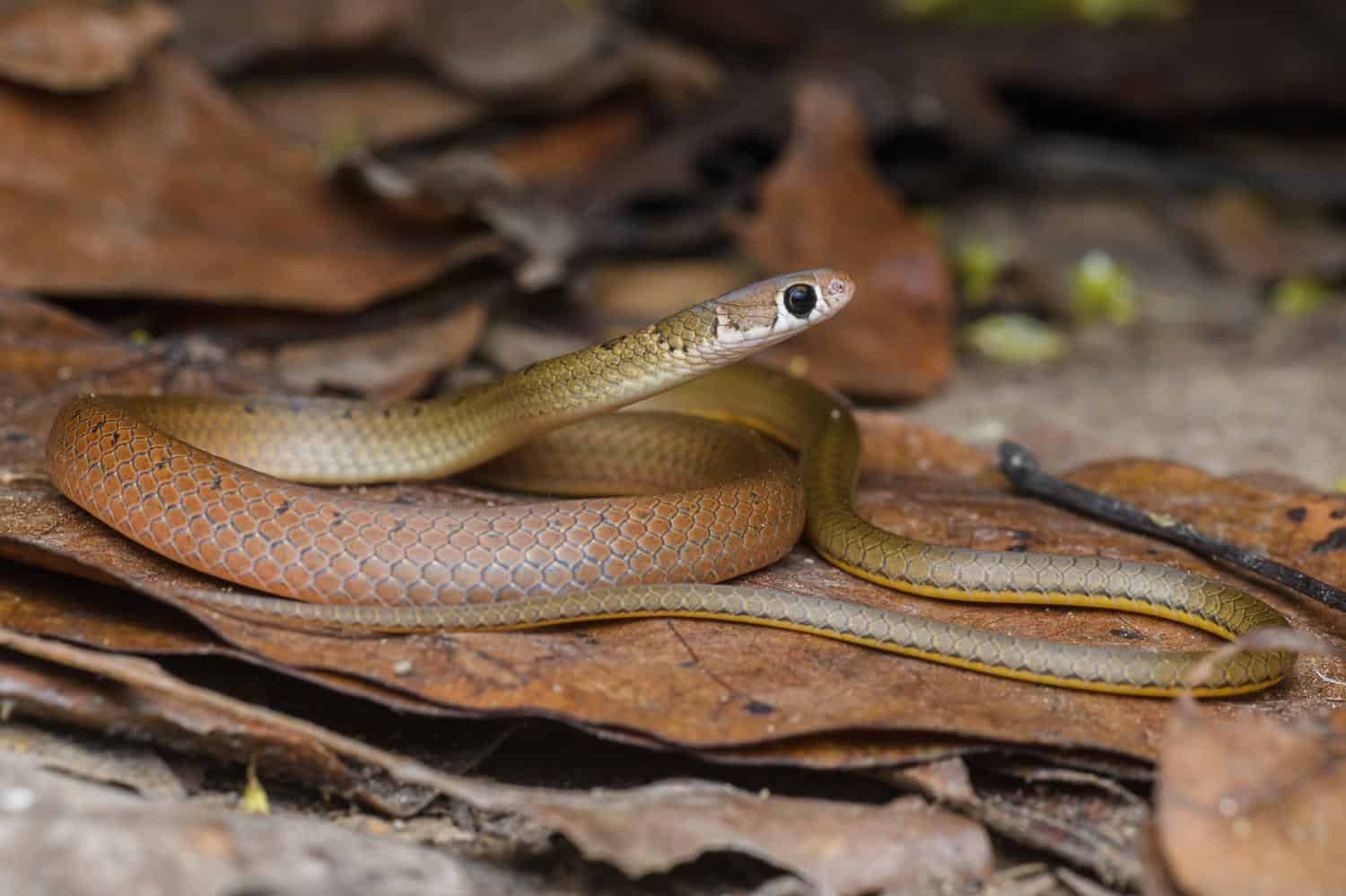
“Little known”, “obscure” and “rarely seen” are some of the phrases used to describe this harmless Thai snake. Gongylosoma scriptum inhabits the low hills of western Thailand, also crossing the border into Myanmar. They reach a maximum of 46.7cm, and move by day, lurking stealthily in mulchy forest debris. Finding the exact location they exist in is a nightmare, and even then, spotting them is incredibly difficult.
Indochinese ground snakes have extremely large eyes, a pale brown body, and a yellow or cream-coloured belly. They’re also found beneath fallen leaves and in loose soil next to forest paths. Almost all individuals discovered so far have been below cover of some kind. They’re so hard to find that only a handful of Indochinese ground snakes are stored in museum collections worldwide.
This species has a thin body and a blunt snout. Nothing is known of their diet in the wild, or their daily life cycle, except that they’re active by day. A 2020 study found 3 more living Indochinese ground snakes, but mainly reconfirmed old findings.
| 8 | Butler’s wolf snake |
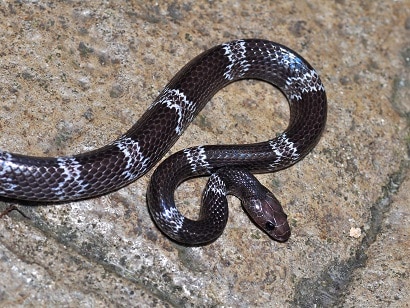
A harmless, medium-sized species which reaches a maximum of 90cm. Butler’s wolf snake (Lycodon butleri) lives in the southern peninsular regions of Thailand, and is just another humble member of the giant Lycodon genus (73 members).
Thailand’s most common Lycodon member is the common wolf snake (Lycodon capunicus), but this is easily separable, with a white neck collar that Butler’s wolf snake totally lacks. Butler’s wolf snake has a precise 40-50 white bands covering its black body. These are large and widely spaced around the neck, but grow closer together as the (thin and whiplike) tail approaches. Butler’s wolf snakes have no colour change on their bodies; the black and encircling white just continue unaltered.
Butler’s wolf snakes are nocturnal and very dark, two facts which combine to make them rarely seen. They’re a ground-dwelling snake which lives mainly in mountain forests, and only bites humans if severely provoked. There’s no bad attitude or nervous twitchiness with Butler’s wolf snake, just the calm spirit of the Thai countryside.
Butler’s wolf snake lacks the power to swallow a human whole. They lack any form of venom at all, and mostly prey on lizards. Watch out though – their patterns closely resemble the deadly venomous Malaysian blue krait. Make sure it really is the Butler’s wolf snake you’re about to touch.
| 9 | Red whip snake |
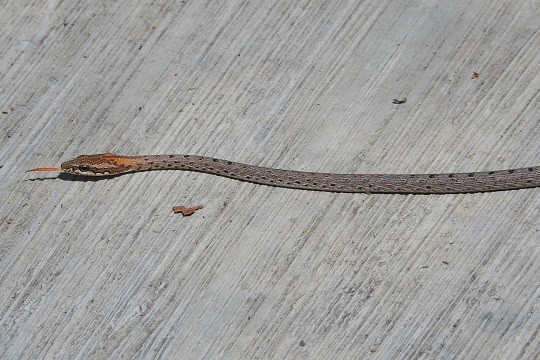
A mildly venomous species which has never killed a human on record. This species measures up to 100cm, and has a large range, including southern Thailand, peninsular and eastern Malaysia, Singapore and Indonesia. Yet within that entire range, they’re very rare.
The red whipsnake (Dryophiops rubescens) is a very thin species, which allows them to slip through gaps in bushes and tree root clusters with ease. Their favourite habitat is evergreen forests below 500 metres. This species mainly feeds on reptiles, such as common flying dragons. In Singapore, a flying dragon landed in a rubber tree directly next to a 45cm red whipsnake, and was photographed being swallowed.
Red whipsnakes like forests, but prefer to stay at the sunnier edges rather than the gnarly interiors. They’re capable of traversing open land, unlike some catsnakes which never leave the safety of the canopies. Red whipsnakes vary in colour from clay to brown, and hence are sometimes called brown whipsnakes. They’re never actually that red, nothing denser than a brick colour. The reddest part is their bright tongue, which almost looks like lipstick when viewed on, as though this is a flirty snake.
| 10 | Berdmore’s slug snake |
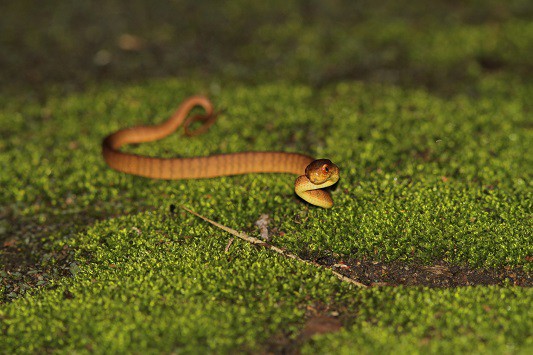
This snake is fairly widespread in Thailand, yet virtually nothing is known of them. Berdmore’s slug snakes (Pareas berdmorei) live across mainland Thailand, including near Bangkok, though are absent from the southern peninsular regions. They measure up to 70cm, and are often seen resting on juicy green leaves, with their thin bodies entwined around a branch for stability. They have the typical round head of a slug-eating snake, with their eyes a rich orange colour which is barely any different to their scales.
Berdmore’s slug snakes have an exceptionally thin tail which would probably snap if it tried to poke you. Though normally orange, some are a duller grey. Their bodies have consistent encircling bands which are only faint in intensity. About their lifestyle, or the precise breakdown of their diet, we know virtually nothing. We only know what we see – that they generally prefer bushes and low tree branches 1 metre above ground, rather than 20 metres high in the towering canopies.
The keeled slug-eating snake (Pareas carinatus) is another member of the family found in Thailand. However, the Berdmore’s version is slightly longer, at 60-70cm versus 50-60cm.
